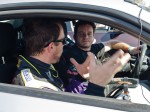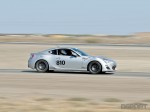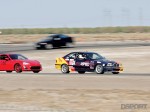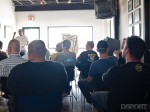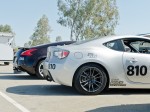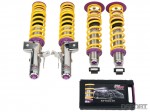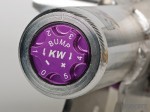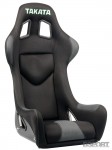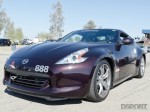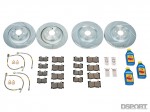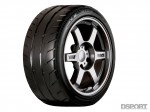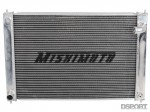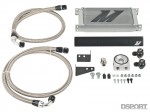JUN | Nissan 370Z
LET’S GET IT STARTED
 After arriving at the track on Sunday, I passed the car through tech and headed to my very first drivers meeting for HPDE 1. Having never driven on the track before, I had no idea what I was getting into. I was nervous, excited, and completely stoked at the same time. For the first session, my instructor Dan “Don” Gardner took me out on a few hot laps to help me get familiarized with the track. Honestly, I almost made a mess in my pants. Soon after, I switched seats with Dan and began my first behind-the-wheel track experience.
After arriving at the track on Sunday, I passed the car through tech and headed to my very first drivers meeting for HPDE 1. Having never driven on the track before, I had no idea what I was getting into. I was nervous, excited, and completely stoked at the same time. For the first session, my instructor Dan “Don” Gardner took me out on a few hot laps to help me get familiarized with the track. Honestly, I almost made a mess in my pants. Soon after, I switched seats with Dan and began my first behind-the-wheel track experience.
BREAKING IT DOWN
At the beginning of the day, my hands kung-fu gripped the steering wheel and my right foot only took two commands, on and off. My eyes locked on to the vehicle directly in front of me as I tried to ingest the real-time advice from Dan while trying to catch up to the car in front. However, after the first session, I realized that I made just about every rookie mistake in the book. Just like walking, you go where you look. The same holds true for the track. My eyes should have been looking way beyond the car in front of me so that I could prepare for the next turn and the one after that. My foot inputs needed to be smoother and my hands didn’t need to pinch the wheel so hard. In fact, the vehicle almost spun in a later session because I pinched the steering so hard over Phil Hill.
[pullquote]I LEARNED THAT GETTING FASTER WITH BAD HABITS REMAINS THE NUMBER ONE CAUSE OF ACCIDENTS[/pullquote]As important as it is to get faster and develop driver’s confidence, I learned that getting faster with bad habits remains the number one cause of accidents. In and out of the classroom, instructors kept pushing for HPDE 1/2 drivers to keep it simple. Dan even went so far as to leave my car in drive mode the whole day so that I wouldn’t worry about shifting. Despite my initial reaction to the ban on shifting, the steering, gas and brakes already provided me plenty of variables to focus on improving. This simplification of driving ultimately made my track experience more rewarding.
SMOOTH MOVES
All day long, I focused on smoothing my inputs. Dan helped me navigate the turns and pointed out places where I needed improvement. Each session, I worked on smooth transitions and letting the car flow on the track rather than forcing the car to move. When asked about how to improve smoothness, Dan responded: “The car’s throttle, brakes and steering are not on and off switches. Each input requires a gradual change. Imagine the dial on a light dimmer, that’s how smooth you should press and release the brakes and throttle and move the wheel.” With the final session of the day, I began to relax more and that confidence afforded me the opportunity to pass a few cars. I’ve never had so much fun before. The track offers enthusiasts the chance to reach new limits with their vehicle and develop improved driving skills. To put it simply, I can’t wait to go back.
WHAT Z NEEDS FOR Z TRACK
 Track preparation requires beefing up a few critical vehicle components that, from the factory, can’t withstand repeated abuse. At minimum, the brakes and tires need replacement as the OE brake pads will begin to fade after repeated hard braking and the factory tires lose grip after a few heat cycles.
Track preparation requires beefing up a few critical vehicle components that, from the factory, can’t withstand repeated abuse. At minimum, the brakes and tires need replacement as the OE brake pads will begin to fade after repeated hard braking and the factory tires lose grip after a few heat cycles.
To ensure that the Z would shed speed at a moments notice, STILLEN provided a complete stopping package. This kit included STILLEN slotted rotors, Goodridge stainless steel braided lines, AP Racing PRF fluid, a set of Hawk HPS pads and a set of Hawk HP Plus pads. You may ask, why two sets of pads? High-performance street pads like the Hawk HPS provide a good compromise of braking performance and minimal noise and dust. For the enthusiast that doesn’t mind a slight increase in noise and dust, Hawk’s HP Plus pads further improve initial bite and resistance to fade. The HPS and HP Plus utilize the same family of friction material, allowing enthusiasts to swap pads without replacing or resurfacing the rotors.
 In conjunction with high performance brakes, increasing the limit of adhesion offered by the tires ultimately stops the vehicle as quickly as possible. To extend this limit of grip, we mounted a set of sticky Nitto NT05s in the 245/40ZR19 front and 275/35ZR19 rear sizes on the factory 19-inch wheels.
In conjunction with high performance brakes, increasing the limit of adhesion offered by the tires ultimately stops the vehicle as quickly as possible. To extend this limit of grip, we mounted a set of sticky Nitto NT05s in the 245/40ZR19 front and 275/35ZR19 rear sizes on the factory 19-inch wheels.

 Although Nissan built a great engine and chassis for the 370Z, the cooling system leaves much room for improvement. Almost all pre-2012 370Z’s suffer from oil cooling issues, with our example reaching over 220°F in traffic on a hot day. As a result, we took precautionary measures and employed a total cooling solution from Mishimoto. This package consisted of Mishimoto’s bolt-on oil cooler kit, all-aluminum radiator and automatic transmission cooler. With these three cooling upgrades, the oil temperatures never ticked above 200°F and the transmission shifted without issue through the last session.
Although Nissan built a great engine and chassis for the 370Z, the cooling system leaves much room for improvement. Almost all pre-2012 370Z’s suffer from oil cooling issues, with our example reaching over 220°F in traffic on a hot day. As a result, we took precautionary measures and employed a total cooling solution from Mishimoto. This package consisted of Mishimoto’s bolt-on oil cooler kit, all-aluminum radiator and automatic transmission cooler. With these three cooling upgrades, the oil temperatures never ticked above 200°F and the transmission shifted without issue through the last session.
PROTECT YOUR HEAD
 Safety remains the number one priority for anyone looking to begin tracking his or her vehicle. NASA requires the driver to have a safe vehicle and a safe helmet. To help us meet the latter requirement, HJC Motorsports invited us to their facility to size Jun’s massive head in the AR-10 helmet. Getting fitted with a properly sized helmet that meets safety certifications such as SNELL is key to both safety and comfort on the track.
Safety remains the number one priority for anyone looking to begin tracking his or her vehicle. NASA requires the driver to have a safe vehicle and a safe helmet. To help us meet the latter requirement, HJC Motorsports invited us to their facility to size Jun’s massive head in the AR-10 helmet. Getting fitted with a properly sized helmet that meets safety certifications such as SNELL is key to both safety and comfort on the track.




